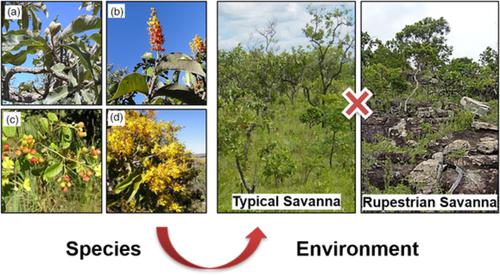当前位置:
X-MOL 学术
›
Ecol. Res.
›
论文详情
Our official English website, www.x-mol.net, welcomes your
feedback! (Note: you will need to create a separate account there.)
The type of substrate does not influence the intraspecific population structure of shrub‐tree species in the Brazilian savanna
Ecological Research ( IF 1.7 ) Pub Date : 2021-03-21 , DOI: 10.1111/1440-1703.12218 José Roberto Rodrigues Pinto 1 , Tassiana Reis R. dos Santos 2, 3 , Pamela Moser 4
Ecological Research ( IF 1.7 ) Pub Date : 2021-03-21 , DOI: 10.1111/1440-1703.12218 José Roberto Rodrigues Pinto 1 , Tassiana Reis R. dos Santos 2, 3 , Pamela Moser 4
Affiliation

|
Local environmental conditions influence the occurrence and abundance of populations, and therefore, the contribution of the same species to the ecological structure and processes of communities can vary in different environments. We investigated the influence of the substrate on the intraspecific population structure of four shrub‐tree species from the Brazilian savanna (Aspidosperma tomentosum, Byrsonima pachyphylla, Davilla elliptica, and Ouratea hexasperma) that occur in adjacent areas, but under different environmental conditions: in shallow soils with rocky outcrops and steep relief in Rupestrian Savanna, and in deep soils and flat relief in Typical savanna. We hypothesized that the relief and physical–chemical conditions of the soil in the Rupestrian Savanna limit the establishment and development of species regarding the abundance of individuals and the horizontal and vertical structure of populations. We found that in the Rupestrian Savanna, the soil has higher levels of total cation exchange capacity and phosphorus, while in Typical Savanna, it is associated with higher pH, base saturation, and clay levels. We show that intraspecific variations do not differ between the two environments in number of individuals, average values of trunk diameter, and total plant height. We observed that the same species contributes in different ways to the structuring of communities in both environments. Our hypothesis was rejected because the population structure was not molded by the substrate type. We conclude that the shrub‐tree species seem to find adaptive alternatives to colonize the different types of substrates, for example, establishing in less stressful microhabitats on the rocky environments.
中文翻译:

基质的类型不影响巴西稀树草原灌木树种的种内种群结构
当地的环境条件影响种群的发生和丰富,因此,同一物种对社区生态结构和过程的贡献在不同环境下可能会有所不同。我们调查了基质对巴西大草原(Aspidosperma tomentosum,Byrsonima pachyphylla,Davilla elliptica和Ouratea hexasperma)四种灌木树种的种内种群结构的影响。)发生在相邻地区,但在不同的环境条件下发生:在Rupestrian Savanna的岩石露头和浅浮雕的浅层土壤中,以及在典型的稀树草原的深层土壤和浅浮雕中。我们假设,Rupestrian Savanna中土壤的起伏和物理化学条件会限制物种的建立和发展,涉及个体的丰富度以及人口的水平和垂直结构。我们发现,在Rupestrian Savanna中,土壤的总阳离子交换能力和磷水平较高,而在典型Savanna中,土壤的pH值,碱饱和度和粘土含量较高。我们表明,在个体数量,树干直径的平均值和总植物高度上,两种环境之间的种内变异没有差异。我们观察到,同一物种在两种环境下以不同的方式为社区的构建做出了贡献。我们的假设被拒绝了,因为总体结构不是由基质类型塑造的。我们得出的结论是,灌木树种似乎找到了适应性的替代方法,以殖民不同类型的基质,例如,在岩石环境中建立了压力较小的微生境。
更新日期:2021-05-17
中文翻译:

基质的类型不影响巴西稀树草原灌木树种的种内种群结构
当地的环境条件影响种群的发生和丰富,因此,同一物种对社区生态结构和过程的贡献在不同环境下可能会有所不同。我们调查了基质对巴西大草原(Aspidosperma tomentosum,Byrsonima pachyphylla,Davilla elliptica和Ouratea hexasperma)四种灌木树种的种内种群结构的影响。)发生在相邻地区,但在不同的环境条件下发生:在Rupestrian Savanna的岩石露头和浅浮雕的浅层土壤中,以及在典型的稀树草原的深层土壤和浅浮雕中。我们假设,Rupestrian Savanna中土壤的起伏和物理化学条件会限制物种的建立和发展,涉及个体的丰富度以及人口的水平和垂直结构。我们发现,在Rupestrian Savanna中,土壤的总阳离子交换能力和磷水平较高,而在典型Savanna中,土壤的pH值,碱饱和度和粘土含量较高。我们表明,在个体数量,树干直径的平均值和总植物高度上,两种环境之间的种内变异没有差异。我们观察到,同一物种在两种环境下以不同的方式为社区的构建做出了贡献。我们的假设被拒绝了,因为总体结构不是由基质类型塑造的。我们得出的结论是,灌木树种似乎找到了适应性的替代方法,以殖民不同类型的基质,例如,在岩石环境中建立了压力较小的微生境。











































 京公网安备 11010802027423号
京公网安备 11010802027423号